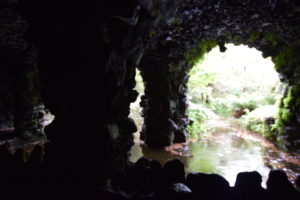Many years ago a Spanish friend was shocked by his compatriots shouting “Ole” after a Fonteyn-Nureyev performance at the Royal Opera House. “Where do they think they are, at a bull ring?” he said. Now we’ve heard them on Good Friday, and wonder what some of our more puritanical coountrymen would make of it.
Semana Santa is, if not a full-blown fiesta, close enough to be mistaken for one. It begins on Palm Sunday (though we were told something happened the day before). The streets are lined with boxes during the preceding week and folding chairs are installed on the Saturday. We made a point of being at a central location well before anything was due to happen, not wishing to be overwhelmed by a rush of spectators. Television cameras were being installed and tested. People seemed unconcerned, but that’s a ploy we’ve noted at Siena before the Palio. There was also a steady stream of pedestrians away from the scene. We followed and found a delightful square, with two of the city’s elegant palaces. A street came into it from the church of San Marco: our leaflet from the tourist office told us we were in the right area. There were also mobile stalls selling nuts, sweets and musical instruments: second clue.
After a while there came a sound that wasn’t the children drumming or blowing toy trumpets. A row of candles came into view, carried by four men in vagely clerical vestments. Then came banners and a procession of penitents reminiscent, as more than one British visitor was to remark, of the KKK. Nothing so sinister however. They were obviously of all ages, from childhood up, and fairly casual, some even having pushed their hoods back off their faces.
Finally the life-size effigies of the Palm Sunday tableau were carried through the plaza. It’s impossible not to be impressed by the care lavished on the figures.or the resilience of the teams of men who carry them in relays. The majority are young men, though we were to see some on Good Friday who might have been close to Silver Traveller status and (on TV) some women who really felt the strain. It takes 20 or more to carry each of the tableaux: I counted 24 under one. They wear something like a horse collar and are replaced every few minutes in a complicated manoeuvre.
We followed the Palm Sunday float through the main streets then, hoping to walk back to our apartment, found ourselves facing the head of the procession. A diversion took us past a reserve team of porters and we found the street we needed. Music told us we were going to be close to the parade for quite some time. I went out again and found a float of the Virgin Mary following a similar route. There seems to be a Mary for every occasion: at least two that evening. and others on other days. Her effigy is always resplendent, with a range of colours on the train stretching out over the rear of the tableau and almost to the ground.
Several days, several processions, but Good Friday – the last chance we would have before the flight home – was amazing. A crowd had gathered outside San Francisco, a church near the city market, but seemed more interested in socialising than gaining a vantage point. We had a position by a barrier facing the church door. Traffic came past but nobody seemed bothered about the risk, even when a bus pushed through almost touching them. Television cameras were again in evidence: the local stations had just the one programme all week, interspersed with what we assumed were discussions of the events.
Finally the church doors opened and the first people emerged. A band had been in the adjacent street but was somehow in position at the church. Candles were visible inside, and slowly approached the door. At the moment the float was to be raised on the mens’ shoulders it tilted. People gasped as though at a disaster, but sighed with relief as it was righted. As it came fully into view there was applause and a chorus of “Ole”. It was almost like the local team had beaten Real Madrid.
For us, what happened next was most impressive. We’d seen people singing laments in flamenco style on TV earlier in the week. And that is exactly what we were about to hear. First a man, then a woman, both of mature years. Their voices were not such as you’d expect to hear in the opera house or even in many a pop concert but they were grave and thrilling in intensity. Occasionally, at a particularly expressive sound the crowd burst into applause: this was what Federico Garcia Lorca had called “Duende” or something very close to it; the kind of sound that raises hair on the neck or shivers the spine.
The tableaux that afternoon were the Crucifixion, of course, and greeted with applause quite alien to the solemn Anglican approach; it was followed by St John, then another Virgin Mary. The city would echo with the music long into the night. Our one regret was in not seeing the Last Supper other than on TV: in many respects it was the most dramatic of all. Semana Santa is a truly joyful week but one with thrilling moments of intensity.















